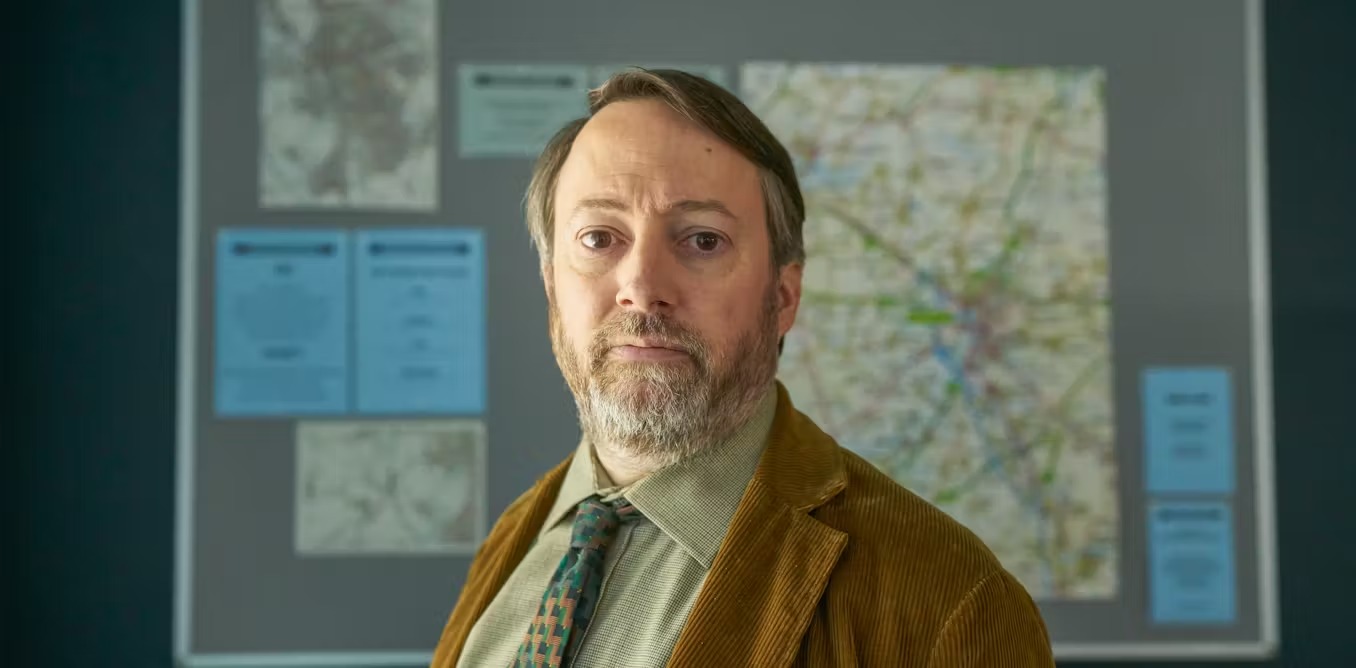“It makes no sense. It’s impossible to solve” – so decries John “Ludwig” Taylor (David Mitchell) when trying to solve a murder using puzzle techniques in the new six-part BBC detective series, Ludwig.
Each week puzzle designer John uses his skill to solve a crime. The show, also starring Anna Maxwell Martin, is guided by the thematic question: “how do we solve life’s puzzles?”
John’s twin brother James (also portrayed by Mitchell) has suddenly gone missing. Enlisted by his sister-in-law Lucy (Maxwell Martin) to help find James, John reluctantly moves in with her and her son, leaving behind his ordered and self-contained (but lonely) world. Lucy wants John to pose as his brother to get some information from James’ office about a case that he was working on, which she suspects is related to his disappearance.
What begins as a benign task very quickly escalates into John taking on James’ role as DCI James Taylor with Cambridge’s Major Crime Squad. John is swept along to crime scenes wherein he proceeds to solve murders using various puzzle techniques: logic puzzles, spot the difference, coincidences (three to be statistically relevant) and even reverse chess (where maths, probability and reason are used to determine prior moves in the middle of a chess game).
The situation creates a bind plot. John wants the love of a family – specifically James’ family – but if he finds James, he will lose the “family” he has found. He is caught between his want (to have a family and Lucy) and his flaw (to learn to engage with people and the world).
In my research, I posit that the bind plot is more prevalent in comedy than in drama. The tension between the want and the flaw is what underpins the comedy.
John is navigating life on two levels: as an imposter detective and as a lonely man with signs of neurodiversity, such as an inability to understand and express feelings, and the need to follow certain rules. This results in misunderstanding and confusion for some of those around John, but not for John himself.
The trailer for Ludwig.
This duality is a common technique in comedy writing. As comic writer Steve Kaplan notes in The Hidden Tools of Comedy (2013), comedy emerges in the gap between the wavy-line character (the confused one) and the straight-line character (with a fixed view on life).
What is interesting in Ludwig is John’s character arc. He begins as a straight-liner, but both his interactions with Lucy and her determination to find her husband force him to question his own life. His increasing confusion about, and interaction with, other people result in him becoming a wavy-line character.
In my book Situation Comedy, Character, and Psychoanalysis (2019) I label the straight-liner as “echo characters”. That’s because they echo the unconscious fear of the main character, while maintaining their own fixed view of the world. It is because the main character is unconscious of this behaviour in themselves that such characters become “trapped” in their dynamic.
These kinds of relationships define the sitcom. Think Phoebe in Friends, who echoes Rachel’s fear of commitment. In the first episode of Friends, Rachel is a runaway bride and Ross is recovering from a failed marriage, setting both these characters up as commitment-phobic. Phoebe, however, embraces life and all its alternatives, no matter how kooky or off-beat.
Moss in The IT Crowd, echoes in a different way. His attention to detail and focus are the antithesis of Roy’s approach to work and Jen’s lack of knowledge of anything to do with IT. Roy fears work and Jen fears being exposed as ignorant, making Moss their perfect echo character.
Maintaining the pretence
The challenge for Ludwig’s head writer and creator, Mark Brotherhood, is to ensure that John can keep up the pretence of being his twin brother, while at the same time ensuring the pretence is believable.
Brotherhood’s previous credits (Father Brown, Death in Paradise, Benidorm and Mount Pleasant) have shown his ability to merge genres such as crime and drama with comic moments.
Set-ups such as characters having recently joined the crimes unit (who did not know James), and fleeting interactions with other characters (who do know James), save John from exposure. But they also distract the audience from the central question – “why don’t other people see that John is a different person?”. Instead we are drawn into the world of puzzles and how they can help solve crimes – and maybe help us solve problems in our own lives.
Dramatic irony enables the audience to be in on the conceit. We know John is not James, but we also know that John is a puzzle master, and we revel in his ability to solve crimes. However, being in on the deception prompts the question: what will happen when John is exposed?
In the vein of Poirot or Miss Marple, John is dedicated to solving murder through reasoned logic as well as increasingly astute observations of human behaviour – something he has avoided until now.
Ludwig is an engaging (and at times puzzling) drama with comic moments, governed by a thematic premise – to understand puzzles is to understand life.



 George Clooney Criticizes Trump’s Tariff Threat, Calls for Film Tax Incentives
George Clooney Criticizes Trump’s Tariff Threat, Calls for Film Tax Incentives  6 simple questions to tell if a ‘finfluencer’ is more flash than cash
6 simple questions to tell if a ‘finfluencer’ is more flash than cash  Oscars 2025: who will likely win, who should win, and who barely deserves to be there
Oscars 2025: who will likely win, who should win, and who barely deserves to be there  Squid Game Finale Boosts Netflix Earnings, But Guidance Disappoints Investors
Squid Game Finale Boosts Netflix Earnings, But Guidance Disappoints Investors  Disney’s ABC Pulls Jimmy Kimmel Live! After Controversial Remarks on Charlie Kirk Killing
Disney’s ABC Pulls Jimmy Kimmel Live! After Controversial Remarks on Charlie Kirk Killing  The quest to extend human life is both fascinating and fraught with moral peril
The quest to extend human life is both fascinating and fraught with moral peril  Mexico Probes Miss Universe President Raul Rocha Over Alleged Criminal Links
Mexico Probes Miss Universe President Raul Rocha Over Alleged Criminal Links  Netflix Shuts Down Boss Fight Entertainment, Developer of “Squid Game: Unleashed” Amid Gaming Strategy Shift
Netflix Shuts Down Boss Fight Entertainment, Developer of “Squid Game: Unleashed” Amid Gaming Strategy Shift  The Mona Lisa is a vampire
The Mona Lisa is a vampire  How Marvel’s Fantastic Four discovered the human in the superhuman
How Marvel’s Fantastic Four discovered the human in the superhuman  Pulp are back and more wistfully Britpop than before
Pulp are back and more wistfully Britpop than before  Some ‘Star Wars’ stories have already become reality
Some ‘Star Wars’ stories have already become reality 




























